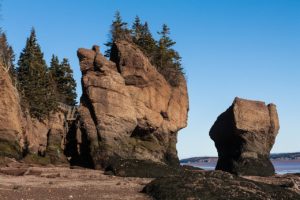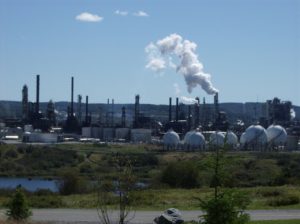Glaciation has left much of New Brunswick’s uplands with only shallow, acidic soils which have discouraged settlement but which are home to enormous forests.
New Brunswick lies entirely within the Appalachian Mountain range. All of the rivers of New Brunswick drain into the Gulf of Saint Lawrence to the east or the Bay of Fundy to the south. These watersheds include lands in Quebec and Maine.

New Brunswick and the rest of the Maritime Peninsula was covered by thick layers of ice during the last glacial period (the Wisconsinian glaciation). It cut U-shaped valleys in the Saint John and Nepisiguit River valleys and pushed granite boulders from the Miramichi highlands south and east, leaving them as erratics when the ice receded at the end of the Wisconsin glaciation, along with deposits such as the eskers between Woodstock and St George, today sources of sand and gravel.
Economy:
As of October 2017 seasonally-adjusted employment is 73,400 for the goods-producing sector and 280,900 for the services-producing sector. Those in the goods-producing industries are mostly employed in manufacturing or construction, while those in services work in social assistance, trades, and health care. A large portion of the economy is controlled by the Irving Group of Companies, which consists of the holdings of the family of K. C. Irving. The companies have significant holdings in agriculture, forestry, food processing, freight transport (including railways and trucking), media, oil, and shipbuilding.
The United States is the province’s largest export market, accounting for 92% of a foreign trade valued in 2014 at almost $13 billion, with refined petroleum making up 63% of that, followed by seafood products, pulp, paper and sawmill products and non-metallic minerals (chiefly potash). The value of exports, mostly to the United States, was $1.6 billion in 2016. About half of that came from lobster. Other products include salmon, crab, and herring. In 2015, spending on non-resident tourism in New Brunswick was $441 million, which provided $87 million in tax revenue.

A large number of residents from New Brunswick are employed in the primary sector of industry. More than 13,000 New Brunswickers work in agriculture, shipping products worth over $1 billion, half of which is from crops, and half of that from potatoes, mostly in the Saint John River valley. McCain Foods is one of the world’s largest manufacturers of frozen potato products. Other products include apples, cranberries, and maple syrup. New Brunswick was in 2015 the biggest producer of wild blueberries in Canada. The value of the livestock sector is about a quarter of a billion dollars, nearly half of which is dairy. Other sectors include poultry, fur, and goats, sheep, and pigs.
About 83% of New Brunswick is forested. Historically important, it accounted for more than 80% of exports in the mid 1800s. By the end of the 1800s the industry, and shipbuilding, were declining due to external economic factors. The 1920s saw the development of a pulp and paper industry. In the mid-1960s, forestry practices changed from the controlled harvests of a commodity to the cultivation of the forests. The industry employs nearly 12,000, generating revenues around $437 million.
